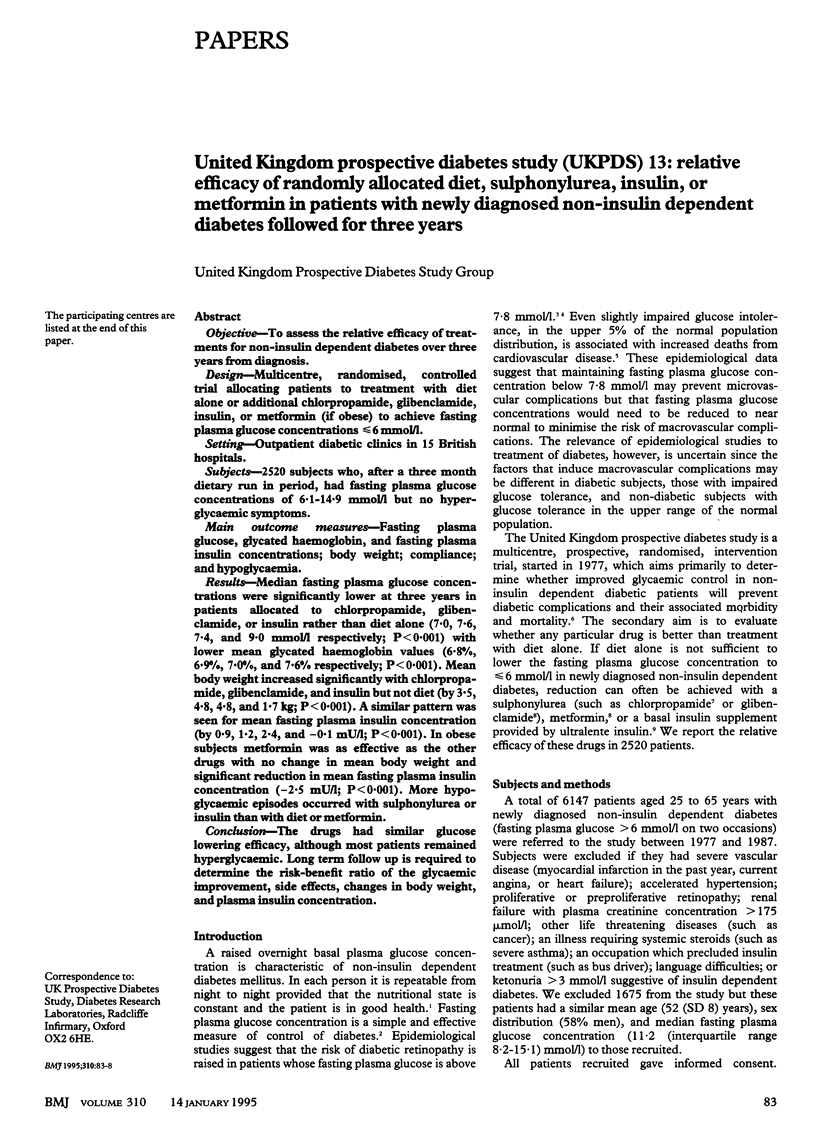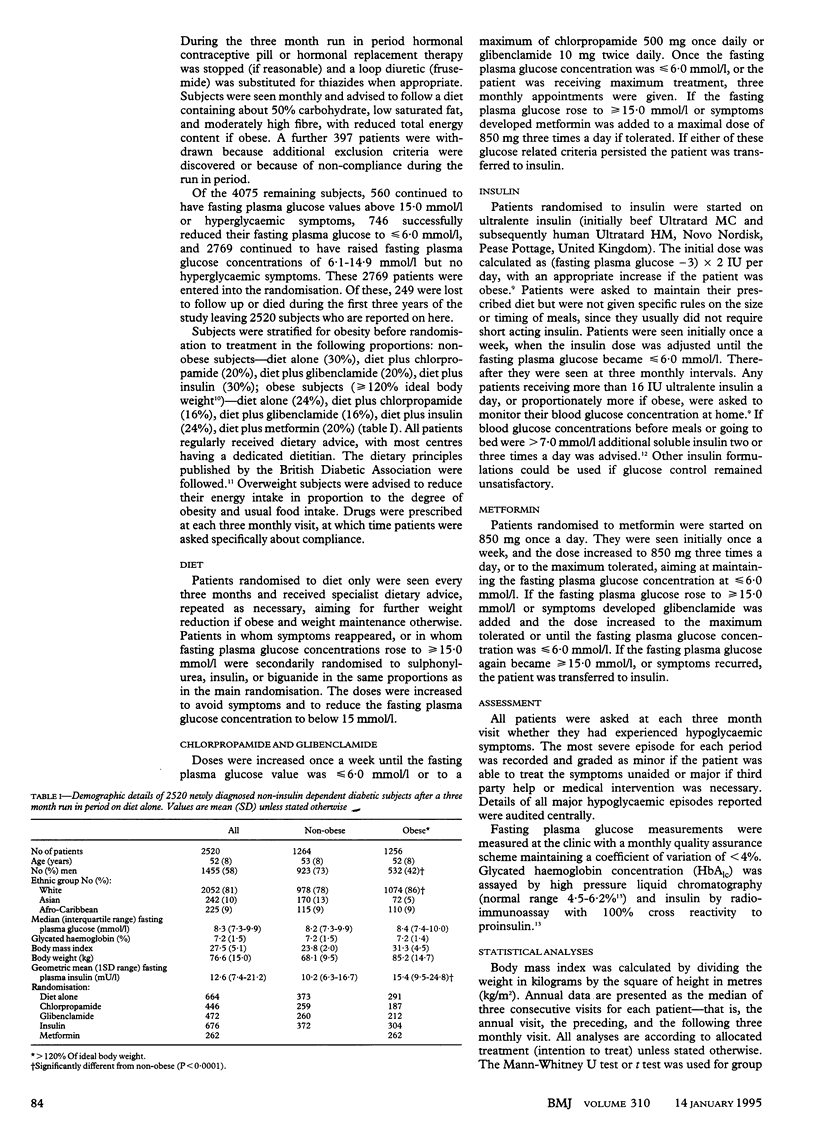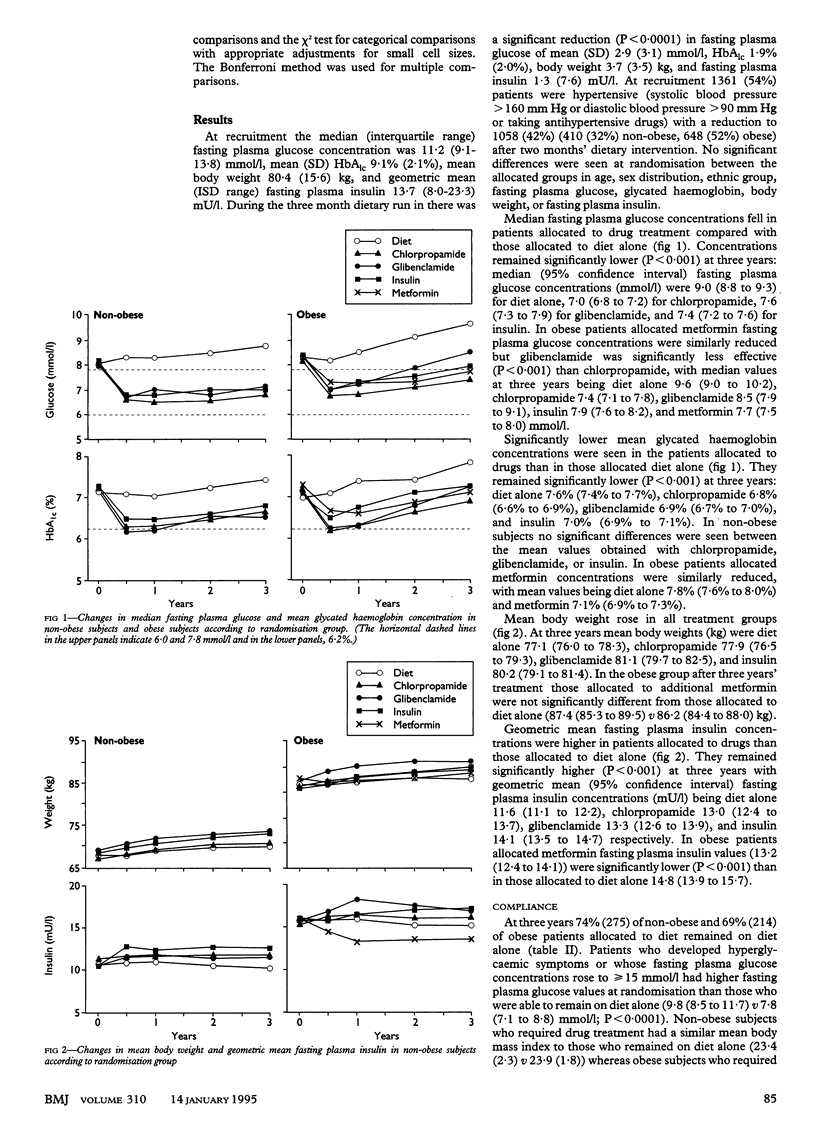Abstract
OBJECTIVE--To assess the relative efficacy of treatments for non-insulin dependent diabetes over three years from diagnosis. DESIGN--Multicentre, randomised, controlled trial allocating patients to treatment with diet alone or additional chlorpropamide, glibenclamide, insulin, or metformin (if obese) to achieve fasting plasma glucose concentrations < or = 6 mmol/l. SETTING--Outpatient diabetic clinics in 15 British hospitals. SUBJECTS--2520 subjects who, after a three month dietary run in period, had fasting plasma glucose concentrations of 6.1-14.9 mmol/l but no hyperglycaemic symptoms. MAIN OUTCOME MEASURES--Fasting plasma glucose, glycated haemoglobin, and fasting plasma insulin concentrations; body weight; compliance; and hypoglycaemia. RESULTS--Median fasting plasma glucose concentrations were significantly lower at three years in patients allocated to chlorpropamide, glibenclamide, or insulin rather than diet alone (7.0, 7.6, 7.4, and 9.0 mmol/l respectively; P < 0.001) with lower mean glycated haemoglobin values (6.8%, 6.9%, 7.0%, and 7.6%, respectively; P < 0.001). Mean body weight increased significantly with chlorpropamide, glibenclamide, and insulin but not diet (by 3.5, 4.8, 4.8, and 1.7 kg; P < 0.001). A similar pattern was seen for mean fasting plasma insulin concentration (by 0.9, 1.2, 2.4, and -0.1 mU/l; P < 0.001). In obese subjects metformin was as effective as the other drugs with no change in mean body weight and significant reduction in mean fasting plasma insulin concentration (-2.5 mU/l; P < 0.001). More hypoglycaemic episodes occurred with sulphonylurea or insulin than with diet or metformin. CONCLUSION--The drugs had similar glucose lowering efficacy, although most patients remained hyperglycaemic. Long term follow up is required to determine the risk-benefit ratio of the glycaemic improvement, side effects, changes in body weight, and plasma insulin concentration.
Full text
PDF





Selected References
These references are in PubMed. This may not be the complete list of references from this article.
- Ducimetiere P., Eschwege E., Papoz L., Richard J. L., Claude J. R., Rosselin G. Relationship of plasma insulin levels to the incidence of myocardial infarction and coronary heart disease mortality in a middle-aged population. Diabetologia. 1980 Sep;19(3):205–210. doi: 10.1007/BF00275270. [DOI] [PubMed] [Google Scholar]
- Fuller J. H., Shipley M. J., Rose G., Jarrett R. J., Keen H. Coronary-heart-disease risk and impaired glucose tolerance. The Whitehall study. Lancet. 1980 Jun 28;1(8183):1373–1376. doi: 10.1016/s0140-6736(80)92651-3. [DOI] [PubMed] [Google Scholar]
- Holman R. R., Turner R. C. A practical guide to basal and prandial insulin therapy. Diabet Med. 1985 Jan;2(1):45–53. doi: 10.1111/j.1464-5491.1985.tb00592.x. [DOI] [PubMed] [Google Scholar]
- Holman R. R., Turner R. C. Basal normoglycemia attained with chlorpropamide in mild diabetes. Metabolism. 1978 May;27(5):539–547. doi: 10.1016/0026-0495(78)90020-3. [DOI] [PubMed] [Google Scholar]
- Holman R. R., Turner R. C. Diabetes: The quest for basal normoglycaemia. Lancet. 1977 Feb 26;1(8009):469–474. doi: 10.1016/s0140-6736(77)91954-7. [DOI] [PubMed] [Google Scholar]
- Howe-Davies S., Simpson R. W., Turner R. C. Control of maturity-onset diabetes by monitoring fasting blood glucose and body weight. Diabetes Care. 1980 Sep-Oct;3(5):607–610. doi: 10.2337/diacare.3.5.607. [DOI] [PubMed] [Google Scholar]
- Jarrett R. J., Keen H. Hyperglycaemia and diabetes mellitus. Lancet. 1976 Nov 6;2(7993):1009–1012. doi: 10.1016/s0140-6736(76)90844-8. [DOI] [PubMed] [Google Scholar]
- Knatterud G. L., Klimt C. R., Levin M. E., Jacobson M. E., Goldner M. G. Effects of hypoglycemic agents on vascular complications in patients with adult-onset diabetes. VII. Mortality and selected nonfatal events with insulin treatment. JAMA. 1978 Jul 7;240(1):37–42. [PubMed] [Google Scholar]
- Loriaux L. Remembrance: Mort and Griff. Endocrinology. 1992 Jul;131(1):1–3. doi: 10.1210/endo.131.1.1611987. [DOI] [PubMed] [Google Scholar]
- Pettitt D. J., Knowler W. C., Lisse J. R., Bennett P. H. Development of retinopathy and proteinuria in relation to plasma-glucose concentrations in Pima Indians. Lancet. 1980 Nov 15;2(8203):1050–1052. doi: 10.1016/s0140-6736(80)92274-6. [DOI] [PubMed] [Google Scholar]
- Pyörälä K., Savolainen E., Lehtovirta E., Punsar S., Siltanen P. Glucose tolerance and coronary heart disease: Helsinki policemen study. J Chronic Dis. 1979;32(11-12):729–745. doi: 10.1016/0021-9681(79)90052-3. [DOI] [PubMed] [Google Scholar]


